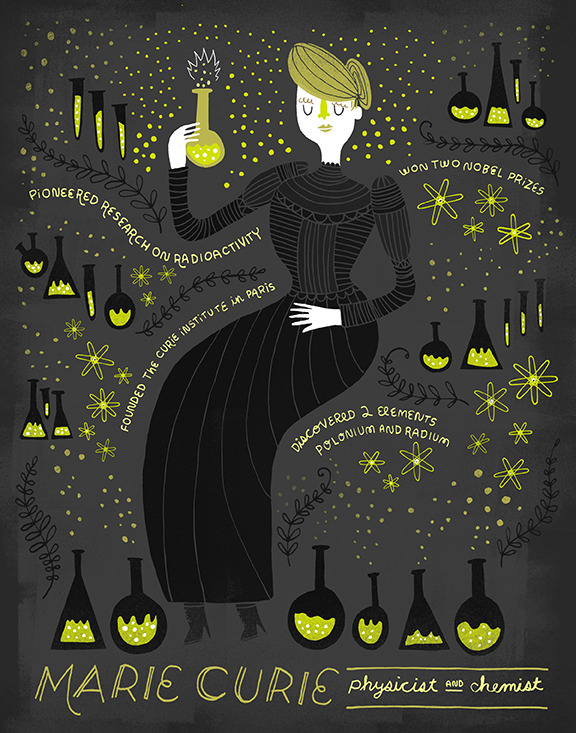"MARIE CURIE" by Rachel Ignotofsky
"Marie Curie Art"
by Rachel Ignotofsky
"I am among those who think that science has great beauty" Marie Curie... WOMEN IN SCIENCE: Pioneers who conquered curiosity against tremendous cultural odds. On #MarieCurie's 151th birthday, an illustrated celebration of trailblazing women in science by Rachel Ignotofsky. She was the first woman to win a Nobel Prize, the first person and only woman to win twice, the only person to win a Nobel Prize in two different sciences, and was part of the Curie family legacy of five Nobel Prizes.

ART "MARIE CURIE" by Rachel Ignotofsky via Etsy
MARIE CURIE
Marie Skłodowska Curie was a Polish and naturalized-French physicist and chemist who conducted pioneering research on radioactivity. She was the first woman to win a Nobel Prize, the first person and only woman to win twice, the only person to win a Nobel Prize in two different sciences, and was part of the Curie family legacy of five Nobel Prizes. She was also the first woman to become a professor at the University of Paris, and in 1995 became the first woman to be entombed on her own merits in the Panthéon in Paris.
"I was taught that the way of progress was neither swift nor easy." Marie Curie
She was born in Warsaw, in what was then the Kingdom of Poland, part of the Russian Empire. She studied at Warsaw's clandestine Flying University and began her practical scientific training in Warsaw. In 1891, aged 24, she followed her older sister Bronisława to study in Paris, where she earned her higher degrees and conducted her subsequent scientific work. She shared the 1903 Nobel Prize in Physics with her husband Pierre Curie and with physicist Henri Becquerel. She won the 1911 Nobel Prize in Chemistry.
Her achievements included the development of the theory of radioactivity, techniques for isolating radioactive isotopes, and the discovery of two elements, polonium and radium. Under her direction, the world's first studies were conducted into the treatment of neoplasms, using radioactive isotopes. She founded the Curie Institutes in Paris and in Warsaw, which remain major centres of medical research today. During World War I, she developed mobile radiography units to provide X-ray services to field hospitals.Amazing ART work
While a French citizen, Marie Skłodowska Curie, who used both surnames, never lost her sense of Polish identity. She taught her daughters the Polish language and took them on visits to Poland. She named the first chemical element that she discovered—polonium, which she isolated in 1898—after her native country.
Marie Curie died in 1934, aged 66, at a sanatorium in Sancellemoz (Haute-Savoie), France, of aplastic anemia from exposure to radiation in the course of her scientific research and in the course of her radiological work at field hospitals during World War I.
"I was taught that the way of progress was neither swift nor easy." Marie Curie
She was born in Warsaw, in what was then the Kingdom of Poland, part of the Russian Empire. She studied at Warsaw's clandestine Flying University and began her practical scientific training in Warsaw. In 1891, aged 24, she followed her older sister Bronisława to study in Paris, where she earned her higher degrees and conducted her subsequent scientific work. She shared the 1903 Nobel Prize in Physics with her husband Pierre Curie and with physicist Henri Becquerel. She won the 1911 Nobel Prize in Chemistry.
Her achievements included the development of the theory of radioactivity, techniques for isolating radioactive isotopes, and the discovery of two elements, polonium and radium. Under her direction, the world's first studies were conducted into the treatment of neoplasms, using radioactive isotopes. She founded the Curie Institutes in Paris and in Warsaw, which remain major centres of medical research today. During World War I, she developed mobile radiography units to provide X-ray services to field hospitals.Amazing ART work
While a French citizen, Marie Skłodowska Curie, who used both surnames, never lost her sense of Polish identity. She taught her daughters the Polish language and took them on visits to Poland. She named the first chemical element that she discovered—polonium, which she isolated in 1898—after her native country.
Marie Curie died in 1934, aged 66, at a sanatorium in Sancellemoz (Haute-Savoie), France, of aplastic anemia from exposure to radiation in the course of her scientific research and in the course of her radiological work at field hospitals during World War I.
WOMENS IN SCIENCE
ART By Rachel Ignotofsky
via brainpickings.org
"An Illustrated Celebration of Trailblazing Women in Science" By Maria Popova via brainpickings.org
Ada Lovelace, Marie Curie, Jane Goodall, Mae Jemison, and more pioneers who conquered curiosity against tremendous cultural odds.
Marie Curie, the first woman to win a Nobel Prize and to this day the only person awarded a Nobel in two different sciences.

WOMEN IN SCIENCE
by Rachel Ignotofsky
rachelignotofskydesign.com
Rachel Ignotofsky is an illustrator, and author based in beautiful Kansas City, MO. She grew up in New Jersey on a healthy diet of cartoons and pudding. She graduated with honors from Tyler School of Art's Graphic Design in 2011. Rachel's first job was at Hallmark Greetings as a Senior Designer until she left to pursue her dreams in 2015.
Now Rachel works for herself and spends all day and night drawing, writing and learning as much as she can. Rachel is a published author with 10 Speed Press and is always thinking up new books and illustrations.
Her work is inspired by history and science. She believes that illustration is a powerful tool that can make learning exciting. She has a passion for taking dense information and making it fun and accessible. Rachel hopes to use her work to spread her message about scientific literacy.

Instagram - Twitter - Facebook
MARIE CURIE LEGACY
The physical and societal aspects of the Curies' work contributed substantially to shaping the world of the twentieth and twenty-first centuries. Cornell University professor L. Pearce Williams observes:
The result of the Curies' work was epoch-making. Radium's radioactivity was so great that it could not be ignored. It seemed to contradict the principle of the conservation of energy and therefore forced a reconsideration of the foundations of physics. On the experimental level the discovery of radium provided men like Ernest Rutherford with sources of radioactivity with which they could probe the structure of the atom. As a result of Rutherford's experiments with alpha radiation, the nuclear atom was first postulated. In medicine, the radioactivity of radium appeared to offer a means by which cancer could be successfully attacked.
If Curie's work helped overturn established ideas in physics and chemistry, it has had an equally profound effect in the societal sphere. To attain her scientific achievements, she had to overcome barriers, in both her native and her adoptive country, that were placed in her way because she was a woman. This aspect of her life and career is highlighted in Françoise Giroud's Marie Curie: A Life, which emphasizes Marie's role as a feminist precursor.
"I am among those who think that science has great beauty" Marie Curie
She was known for her honesty and moderate life style. Having received a small scholarship in 1893, she returned it in 1897 as soon as she began earning her keep. She gave much of her first Nobel Prize money to friends, family, students, and research associates. In an unusual decision, Curie intentionally refrained from patenting the radium-isolation process, so that the scientific community could do research unhindered. She insisted that monetary gifts and awards be given to the scientific institutions she was affiliated with rather than to her. She and her husband often refused awards and medals. Albert Einstein reportedly remarked that she was probably the only person who could not be corrupted by fame.

SOURCE: "MARIE CURIE" by WIKIPEDIA (CC BY SA)
"MARIE CURIE" by Rachel Ignotofsky via etsy
www.rachelignotofskydesign.com
"An I llustrated Celebration of Trailblazing Women in Science" By Maria Popova via brainpickings.org
"No Copyright Infringement Intended, Strictly For Promotional Purposes Only! All Rights Reserved To Their Respective Owners."
"Copyright Disclaimer Under Section 107 of the Copyright Act 1976, allowance is made for "fair use" for purposes such as criticism, comment, news reporting, teaching, scholarship, and research. Fair use is a use permitted by copyright statute that might otherwise be infringing. Non-profit, educational or personal use tips the balance in favor of fair use."


















































0 comentarios :